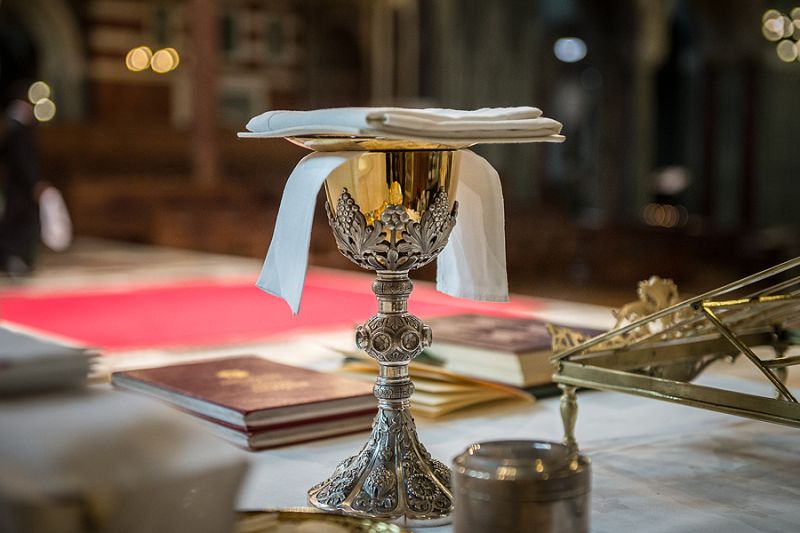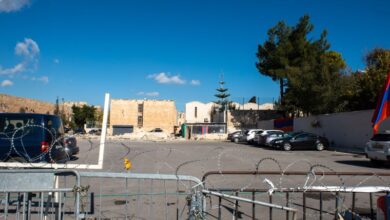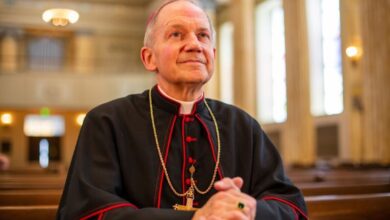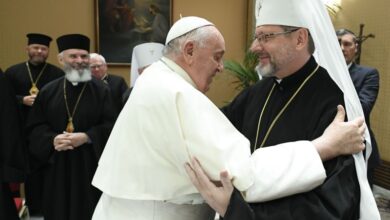Holy Communion from the chalice reintroduced in the UK: What about the U.S.?

 null / © Mazur/catholicnews.org.uk
null / © Mazur/catholicnews.org.uk Washington D.C., Mar 2, 2023 / 16:00 pm (CNA).
The bishops of England and Wales announced this week that the distribution of holy Communion from the chalice during Mass will resume starting Holy Thursday.
The U.K. bishops’ announcement comes after COVID-19 transmission concerns caused a three-year hiatus in the use of the chalice to distribute Communion.
Auxiliary Bishop John Sherrington of the Archdiocese of Westminster explained in a letter to priests that the resumption of Communion through the chalice on Holy Thursday allows pastors a period to educate the faithful on the importance of Communion in both forms.
“The period leading up to Holy Thursday presents an opportunity for appropriate catechesis of the faithful regarding the significance of the reception of holy Communion under either or both species,” Sherrington wrote.
“Important teaching, such as the totality of the body, blood, soul, and divinity of the Lord is received in either or both species, the personal disposition of those receiving holy Communion, and the reverence offered to the Blessed Sacrament should be included,” he wrote.
The bishops’ announcement has been met with enthusiasm in the U.K.
“I understood and supported the temporary withdrawal of the chalice on health grounds, but it still felt like a loss,” said Father Philip Dyer-Perry, a parish priest at the Church of Our Lady of the Rosary in Staines, England. “There is so much richness in understanding the Eucharist not only as food but also as drink.”
So, what about the U.S.?
The United States Conference of Catholic Bishops (USCCB) has not taken a position on the question but is leaving it up to individual bishops and dioceses.
Father Andrew Menke, executive director of the U.S. bishops’ Secretariat of Divine Worship, told CNA that “distribution of Communion is always governed by the local bishop.”
“One of the downsides of the USCCB is that we’re just so big and it’s such a large geographic territory with such different circumstances,” Menke said. “In a smaller conference like England and Wales, it’s not so difficult for the bishops to all get together to decide on a uniform policy. In the U.S. that is just not a feasible way for our bishops to operate.”
Menke was not able to say how many dioceses continue to restrict the distribution of Communion to just the body of Christ. However, he said that many, if not most, dioceses have begun allowing pastors to decide.
Just this Sunday, the Diocese of El Paso, led by Bishop Mark Seitz, began allowing parishes to distribute Communion in both species.
Fernando Ceniceros, communications director for the Diocese of El Paso, told CNA that the diocese felt it was “the right time” and that the decision was made to help the faithful have “the opportunity to have Communion in full by both species.”
The Archdiocese of Galveston-Houston, under the leadership of Cardinal Daniel DiNardo, resumed Communion through the chalice on Epiphany Sunday, Jan. 8.
“Cardinal DiNardo asked all parishes to resume their customary pre-pandemic practice of distributing the precious blood to the faithful at holy Communion on Epiphany Sunday,” said Dan Girardot of the archdiocese’s worship office. “While Communion under one kind is not lacking in any way theologically, there is a fullness in the outward expression of the sacred reality of the Eucharist when receiving both the body and blood of Christ.”
Father Nile Gross, director of the Archdiocese of New Orleans’ Office of Worship, announced last November that Archbishop Gregory Aymond had removed all restrictions on the distribution of Communion.
Gross added that the decision marked “an important moment in the life of the archdiocese.”
“COVID happened and continues to pose serious health threats. However, guided by prayer and the guidance of health officials, Archbishop Aymond has decided it is time to strengthen our liturgical life in this important gesture,” Gross said.
It’s important to note that many dioceses that have lifted COVID-era restrictions on the Communion chalice still leave the ultimate decision to individual pastors and parishes.
Other dioceses that have returned to the use of the Communion chalice include the Archdioceses of Seattle and Denver and the Dioceses of Youngstown, Cleveland, Pittsburgh, and Salt Lake City.
When the Diocese of Colorado Springs resumed Communion with the chalice last fall, Bishop James Golka wrote that while the Catechism of the Catholic Church states that “Communion under the species of bread alone makes it possible to receive all the fruit of eucharistic grace,” it also says that receiving it in both forms is “more complete.”
He referred to the Catechism: “The sign of communion is more complete when given under both kinds, since in that form the sign of the Eucharistic meal appears more clearly’” (No. 1390), and the third edition of the Roman Missal:
“Holy Communion has a fuller form as a sign when it takes place under both kinds. For in this form the sign of the Eucharistic banquet is more clearly evident and clearer expression is given to the divine will by which the new and eternal Covenant is ratified in the Blood of the Lord, as also the connection between the Eucharistic banquet and the eschatological banquet in the Kingdom of the Father.”
The General Instruction further states that “at the same time the faithful should be instructed to participate more readily in this sacred rite, by which the sign of the Eucharistic banquet is made more fully evident” (GIRM, 281; Norms, 20).





